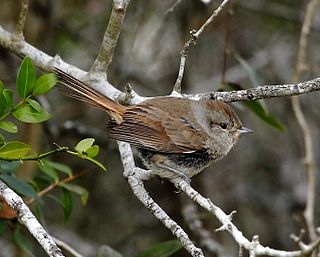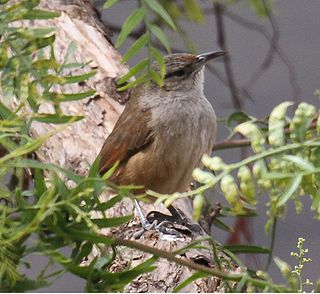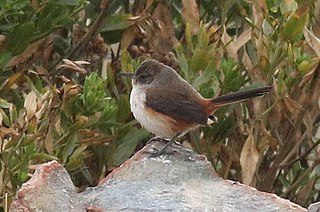
The streaked tuftedcheek is a passerine bird in the Furnariinae subfamily of the ovenbird family Furnariidae. It is found in Bolivia, Colombia, Ecuador, Peru, and Venezuela.

The austral canastero is a species of bird in the Furnariinae subfamily of the ovenbird family Furnariidae. It is found in Argentina and Chile.

The short-billed canastero is a species of bird in the Furnariinae subfamily of the ovenbird family Furnariidae. It is found in Argentina, Bolivia, Brazil, Paraguay, and Uruguay.

Berlepsch's canastero is a Near Threatened species bird in the Furnariinae subfamily of the ovenbird family Furnariidae. It is endemic to Bolivia.

The rusty-vented canastero, or creamy-breasted canastero, is a species of bird in the Furnariinae subfamily of the ovenbird family Furnariidae. It is found in Argentina and Bolivia.

The many-striped canastero is a species of passerine bird in the Furnariinae subfamily of the ovenbird family Furnariidae. It is found in Colombia, Ecuador, and Peru.

Hudson's canastero is a Near Threatened species of bird in the Furnariinae subfamily of the ovenbird family Furnariidae. It is found in Argentina, Brazil, and Uruguay.

The scribble-tailed canastero is a species of bird in the Furnariinae subfamily of the ovenbird family Furnariidae. It is found in Argentina, Bolivia, and Peru.

The cordilleran canastero is a species of bird in the Furnariinae subfamily of the ovenbird family Furnariidae. It is found in Argentina, Bolivia, Chile, and Peru.

The sharp-billed canastero or lesser canastero is a species of bird in the Furnariinae subfamily of the ovenbird family Furnariidae. It is found in Argentina, Bolivia, Chile, Paraguay, and Uruguay, and has also occurred as a vagrant in Brazil.

The line-fronted canastero is a Near Threatened species of bird in the Furnariinae subfamily of the ovenbird family Furnariidae. It is found in Bolivia and Peru.

The streak-backed canastero is a species of bird in the Furnariinae subfamily of the ovenbird family Furnariidae. It is found in Argentina, Bolivia, Colombia, Ecuador, Peru, and Venezuela.

The slender-billed miner is a species of bird in the subfamily Sclerurinae, the leaftossers and miners, of the ovenbird family Furnariidae. It is found in Argentina, Bolivia, Ecuador, and Peru.

The Andean tit-spinetail is a species of bird in the Furnariinae subfamily of the ovenbird family Furnariidae. It is found in Bolivia, Colombia, Ecuador, Peru, and Venezuela.

The pearled treerunner is a species of bird in the Furnariinae subfamily of the ovenbird family Furnariidae. It is found in Bolivia, Colombia, Ecuador, Peru, Venezuela, and possibly Argentina.

The streak-fronted thornbird is a species of bird in the Furnariinae subfamily of the ovenbird family Furnariidae. It is found in Argentina, Boliva, and Peru.

The slender-billed xenops is a species of bird in the Furnariinae subfamily of the ovenbird family Furnariidae. It is found in Bolivia, Brazil, Colombia, Ecuador, French Guiana, Guyana, Peru, Suriname, and Venezuela.

The olive-backed woodcreeper is a species of bird in the subfamily Dendrocolaptinae of the ovenbird family Furnariidae. It is found in Bolivia, Colombia, Ecuador, Peru, and Venezuela.

The dark-winged canastero, or Arequipa canastero, is a species of bird in the Furnariinae subfamily of the ovenbird family Furnariidae. It is found in Bolivia, Chile, and Peru.

The pale-tailed canastero, is a species of bird in the Furnariinae subfamily of the ovenbird family Furnariidae. It is endemic to Peru.























